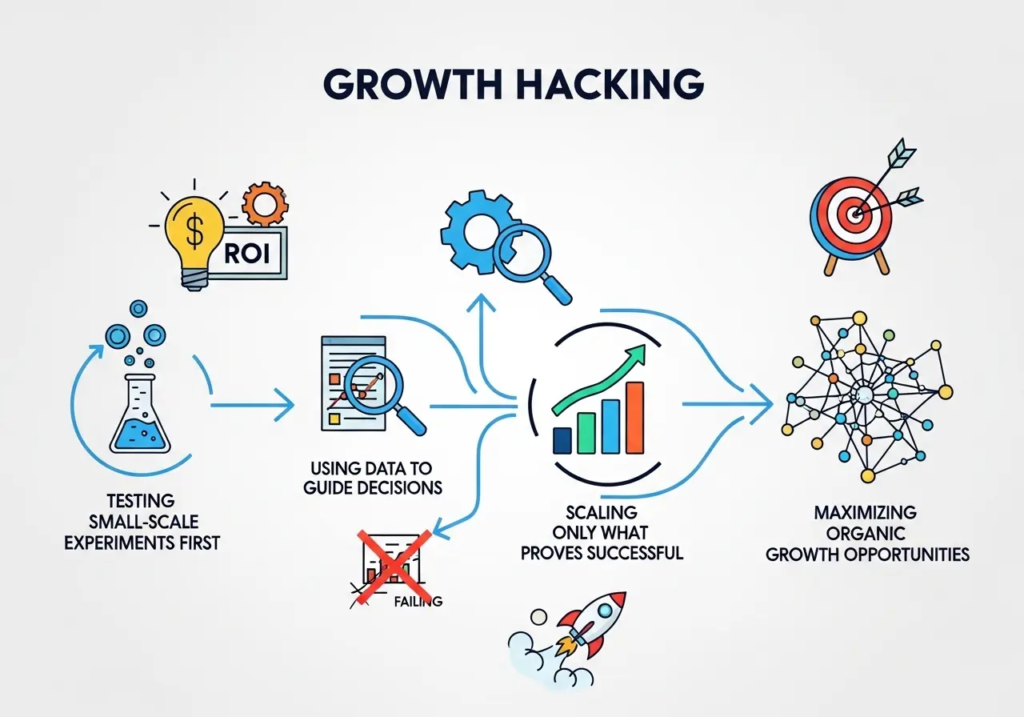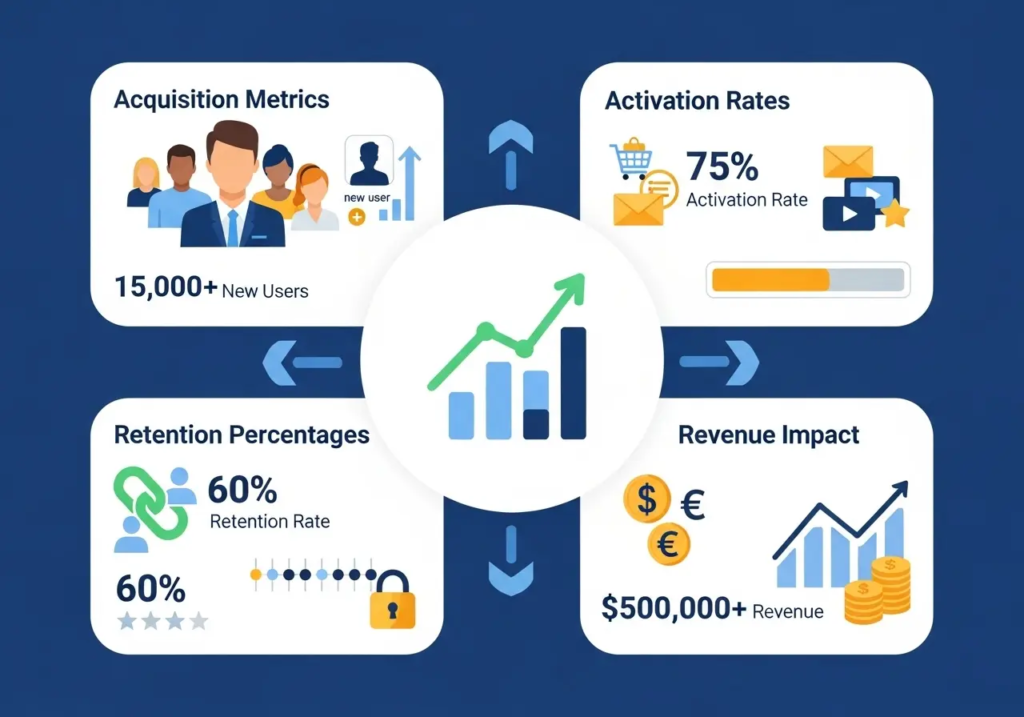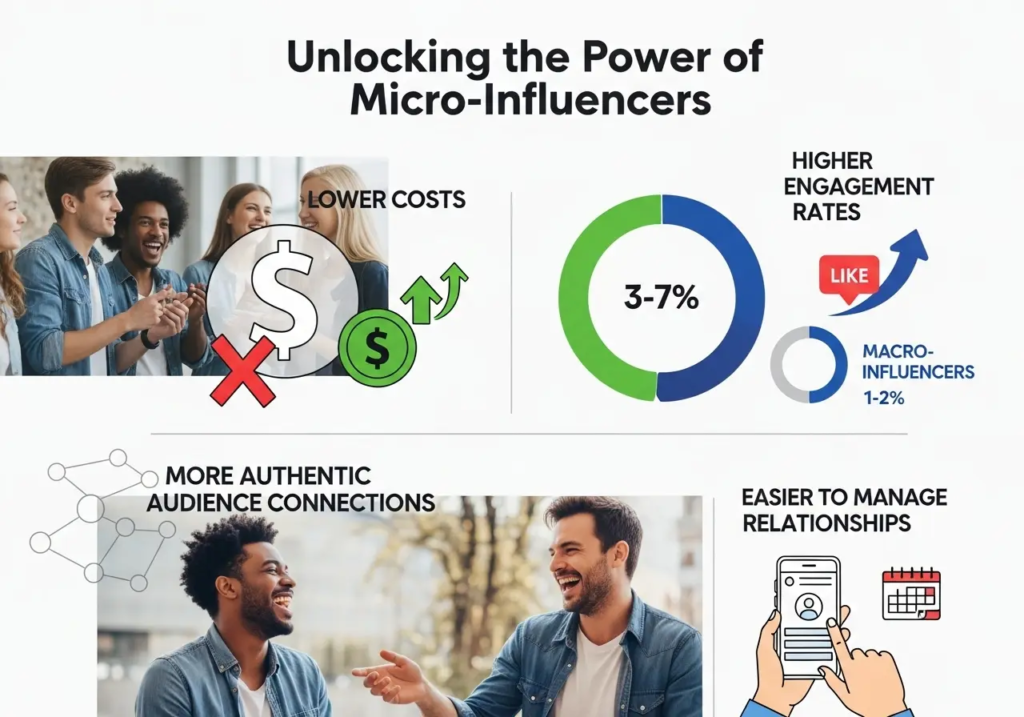
Master 10 proven growth hacking techniques that startups and tech companies use to scale rapidly. Get actionable strategies that work in 2025. Start growing today!
Table of Contents
- What Are Growth Hacking Techniques and Why They Matter
- The Growth Hacking Mindset Every Founder Needs
- Top 10 Growth Hacking Techniques That Actually Work
- Advanced Growth Hacking Techniques for Scaling
- Common Growth Hacking Mistakes to Avoid
- How to Measure Your Growth Hacking Success
- FAQ: Growth Hacking Techniques
Introduction
Picture this: Your startup has an amazing product, but you’re burning through cash faster than a Formula 1 car burns fuel. Sound familiar?
You’re not alone. 85% of startups use growth hacking strategies, and there’s a good reason why. Traditional marketing can drain your budget before you see meaningful results. Growth hacking techniques offer a smarter path forward.
This guide reveals 10 proven growth hacking techniques successful companies use to scale rapidly without breaking the bank. You’ll discover practical strategies, real examples, and actionable steps you can implement immediately.
By the end of this post, you’ll have a clear roadmap to accelerate your growth using data-driven methods that work in 2025.
What Are Growth Hacking Techniques and Why They Matter
Growth hacking techniques are creative, low-cost strategies focused on rapid business growth. Unlike traditional marketing, these methods prioritize experimentation, data analysis, and scalable results.
The core principle is simple: find the most efficient ways to acquire, activate, and retain customers using minimal resources. Growth hacking uses cost-effective techniques to bring potential customers into the funnel, like guest posting and social media marketing.
Why Traditional Marketing Falls Short for Startups
Traditional marketing requires significant upfront investment. TV ads, print campaigns, and billboards cost thousands of dollars with uncertain returns. Startups can’t afford to gamble on expensive campaigns that might not work.
Growth hacking techniques solve this problem by:
- Testing small-scale experiments first
- Using data to guide decisions
- Scaling only what proves successful
- Maximizing organic growth opportunities

This approach explains why companies implementing growth hacking see a 60% faster growth rate than traditional methods.
The Growth Hacking Mindset Every Founder Needs
Before diving into specific techniques, you need to adopt the right mindset. Growth hacking isn’t button-clicking; it’s smart, structured thinking.
The T-Shaped Marketer Approach
Successful growth hackers are T-shaped professionals. They have:
- Broad knowledge across multiple disciplines (the horizontal bar)
- Deep expertise in one specific area (the vertical bar)
This combination allows you to see connections others miss and execute strategies effectively.
Data-Driven Decision Making
Every growth hacking technique should be measurable. You need to track:
- Acquisition metrics (how many new users)
- Activation rates (users taking key actions)
- Retention percentages (users staying active)
- Revenue impact (bottom-line results)

Without data, you’re just guessing. With data, you’re strategically growing.
Top 10 Growth Hacking Techniques That Actually Work
Here are the most effective growth hacking techniques that startups and tech companies use to scale rapidly in 2025:
1. Viral Referral Programs
Viral referral programs turn your customers into your marketing team. The strategy works because people trust recommendations from friends more than advertisements.
How to implement:
- Offer incentives for both referrer and referee
- Make sharing extremely easy (one-click processes)
- Create urgency with limited-time bonuses
- Track which referral sources perform best
For example, using referral rewards, Dropbox grew from 100,000 to 4 million users in 15 months. They offered extra storage space for successful referrals.
2. Content Virality and Social Proof
Creating shareable content that naturally spreads across social platforms can exponentially increase your reach without paid advertising.
Key elements for viral content:
- Emotional triggers (humor, surprise, inspiration)
- Visual appeal (infographics, videos, memes)
- Practical value (tips, tutorials, insights)
- Easy sharing mechanics
Pro tip: Use tools like BuzzSumo to identify what content performs well in your industry, then create better versions.
3. Product-Led Growth Strategy
Your product becomes your primary growth driver. This technique works especially well for SaaS companies and digital products.
Implementation steps:
- Build growth directly into your product features
- Create natural expansion opportunities
- Use freemium models to reduce the barrier to entry
- Design features that require user collaboration
Example: Slack grew rapidly because teams naturally invited colleagues to join their workspace. The product itself drove user acquisition.
4. Strategic Partnership and Cross-Promotion
Partner with complementary businesses to tap into their customer base. This growth hacking technique leverages existing relationships for mutual benefit.
Partnership strategies:
- Content collaboration (co-created resources)
- Technology integrations
- Cross-promotional campaigns
- Joint webinars or events
Success factor: Choose partners whose audience aligns with your target market but isn’t direct competition.
5. Gamification and User Engagement
Transform user interactions into game-like experiences. Gamified referrals are becoming increasingly popular among startups looking to boost engagement.
Gamification elements:
- Progress bars and achievement badges
- Leaderboards and competitions
- Point systems and rewards
- Challenges and milestones
This technique increases user retention and encourages desired behaviors naturally.
6. Micro-Influencer Marketing Campaigns
Micro-influencer swarms are proving more effective than celebrity endorsements for many startups. These smaller influencers often have higher engagement rates and more targeted audiences.
Benefits of micro-influencers:
- Lower costs than macro-influencers
- Higher engagement rates (3-7% vs 1-2%)
- More authentic audience connections
- Easier to manage relationships

Implementation: Focus on influencers with 1,000-100,000 followers in your niche.
7. AI-Driven Personalization and Optimization
AI-driven optimization helps you personalize user experiences at scale. Tailor the content you display on the homepage based on the visitors’ demographics and previous behaviors.
AI applications for growth:
- Dynamic content personalization
- Predictive lead scoring
- Automated A/B testing
- Behavioral trigger campaigns
This technique improves conversion rates by delivering relevant experiences to each user.
8. Community Building and User-Generated Content
Build a community around your brand where users create content, share experiences, and help each other. This creates powerful network effects.
Community growth strategies:
- Create valuable discussion spaces
- Encourage user-generated content
- Recognize and reward active members
- Facilitate peer-to-peer connections
Example: ProductHunt built a thriving community of makers and early adopters who actively promote new products.
9. Conversion Funnel Optimization
Optimize every step of your user journey to maximize conversions. Small improvements at each stage compound for a significant growth impact.
Key optimization areas:
- Landing page conversion rates
- Sign-up process simplification
- Onboarding experience improvement
- Email sequence performance
Testing approach: Run continuous A/B tests on critical funnel elements. Even 1% improvements add up quickly.
10. Strategic Content Marketing and SEO
Create content that attracts your ideal customers through search engines and social sharing. This technique provides long-term, scalable growth.
Content growth strategies:
- Target long-tail keywords your competitors ignore
- Create comprehensive resource guides
- Build topic authority through consistent publishing
- Optimize for featured snippets and voice search
Pro tip: Focus on solving your target audience’s problems rather than promoting your product directly.
Advanced Growth Hacking Techniques for Scaling
Once you’ve mastered the basics, these advanced growth hacking techniques can accelerate your scaling:
Viral Loop Engineering
Design your product so users naturally invite others as part of normal usage. This creates exponential growth without additional marketing spend.
Viral loop components:
- Trigger (reason to invite others)
- Invitation mechanism (how invites are sent)
- Conversion process (how invitees become users)
- Reward system (benefits for all parties)
Network Effect Optimization
Build features that become more valuable as more people use them. This creates natural barriers to competition and accelerates growth.
Advanced Automation and Growth Stacks
Use sophisticated tool combinations to automate growth processes:
- Marketing automation platforms
- Customer data platforms
- Analytics and attribution tools
- A/B testing software
The key is creating seamless workflows that nurture leads and optimize conversions automatically.
Common Growth Hacking Mistakes to Avoid
Learn from these common pitfalls that derail many growth hacking efforts:
Focusing on Vanity Metrics
Page views and social media followers feel good, but don’t necessarily drive business results. Focus on metrics that directly impact revenue:
- Customer acquisition cost (CAC)
- Customer lifetime value (LTV)
- Monthly recurring revenue (MRR)
- Churn rate
Copying Tactics Without Strategy
Copying tactics without a plan won’t bring growth. What works for one company might not work for yours. Always:
- Understand why a technique works
- Adapt it to your specific situation
- Test before scaling
- Measure results carefully
Neglecting Product-Market Fit
No growth hacking technique can save a product that people don’t want. Ensure you have a strong product-market fit before investing heavily in growth tactics.
Scaling Too Quickly
Rapid growth can break your systems and hurt user experience. Scale gradually and ensure your infrastructure can handle increased demand.
How to Measure Your Growth Hacking Success
Measuring the effectiveness of your growth hacking techniques is crucial for continued success. Here’s how to track what matters:
Essential Growth Metrics
Acquisition Metrics:
- Traffic sources and quality
- Conversion rates by channel
- Customer acquisition cost (CAC)
- Time to acquire customers
Activation Metrics:
- User onboarding completion rates
- Time to first value
- Feature adoption rates
- Initial engagement levels
Retention Metrics:
- Daily/Monthly active users
- Churn rate by cohort
- Customer lifetime value (LTV)
- Product usage depth
Growth Hacking Analytics Tools
Free Tools:
- Google Analytics for web traffic
- Facebook Analytics for social insights
- Google Search Console for SEO performance
- Mailchimp for email marketing metrics
Paid Tools:
- Mixpanel for advanced user analytics
- Hotjar for user behavior insights
- Optimizely for A/B testing
- HubSpot for comprehensive growth tracking
Creating Growth Reports
Develop regular reporting that shows:
- Week-over-week growth trends
- Performance by growth channel
- Experiment results and learnings
- ROI of different growth techniques
This data helps you double down on what works and eliminate what doesn’t.
FAQ: Growth Hacking Techniques
Q: How long does it take to see results from growth hacking techniques?
A: Results vary by technique and industry. Some tactics, like referral programs, can show results within weeks, while content marketing and SEO may take 3-6 months. The key is consistent testing and optimization.
Q: What’s the difference between growth hacking and traditional marketing?
A: Growth hacking focuses on rapid experimentation, data-driven decisions, and scalable techniques with limited budgets. Traditional marketing relies more on established channels and larger upfront investments.
Q: Can established companies use growth hacking techniques?
A: Absolutely. While growth hacking originated with startups, established companies can adapt these techniques to launch new products, enter new markets, or optimize existing growth channels.
Q: How much of my budget do I need for growth hacking?
A: Growth hacking techniques are designed to be low-cost. You can start with as little as $100-$500 monthly for tools and small experiments. The focus is on creativity and optimization rather than big spending.
Q: What’s the most important growth hacking technique for beginners?
A: Start with conversion funnel optimization. It’s foundational, measurable, and directly impacts all other growth efforts. Once you understand your users’ journey, other techniques become more effective.
Q: How do I choose which growth hacking techniques to try first?
A: Consider these factors:
- Your current biggest growth bottleneck
- Available resources and skills
- Time to see results
- Potential impact on key metrics
Start with 1-2 techniques you can execute well rather than trying everything simultaneously.
Q: Are growth hacking techniques ethical?
A: When done properly, yes. Focus on providing genuine value to users and being transparent about your methods. Avoid manipulative tactics that might work short-term but damage long-term trust.
Ready to Accelerate Your Growth?
These 10 growth hacking techniques have helped thousands of startups and tech companies scale rapidly without massive marketing budgets. The key is starting with one technique, testing thoroughly, and scaling what works.
Remember: growth hacking isn’t about overnight success. It’s about building systematic approaches to sustainable growth through continuous experimentation and optimization.
Your next step: Choose one technique from this list that aligns with your current situation and resources. Set up proper tracking, run a small test, and measure the results. Once you see positive outcomes, add another technique to your growth stack.
Want more growth resources and step-by-step implementation guides? Download our free growth hacking toolkit with templates, checklists, and case studies to accelerate your results.

